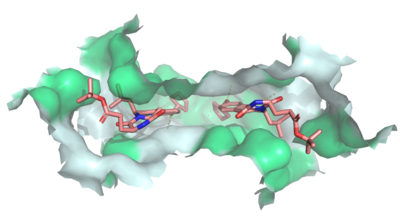Sandbox Reserved 1613
From Proteopedia
(Difference between revisions)
| Line 35: | Line 35: | ||
As previously stated, by utilizing certain binders(<scene name='83/832939/5d3-fab/2'>5D3</scene>), it is able to be stabilized for crystallographic imaging.<ref name="Taylor">PMID:28554189</ref> This has allowed researchers in the past decade to make advances based upon the greater understanding of its structure. Using these advances, inhibitors have been found to stop effluxion by ABCG2. Completely inhibiting this function, however, has residual effects on the excretory system. One such effect is decreased uric acid excretion in both the kidneys and the gut, which causes [https://en.wikipedia.org/wiki/Hyperuricemia hyperuricemia] . This results in an increased risk of uric acid crystal build-up, known as [https://en.wikipedia.org/wiki/Tophus tophi formation], which causes a type of arthritis known as [https://en.wikipedia.org/wiki/Gout gout] . Balancing the inhibition of ABCG2 will determine how to lessen these effects while continuing to combat cancer resistivity.<ref name="Cleophas">PMID:28461764</ref> | As previously stated, by utilizing certain binders(<scene name='83/832939/5d3-fab/2'>5D3</scene>), it is able to be stabilized for crystallographic imaging.<ref name="Taylor">PMID:28554189</ref> This has allowed researchers in the past decade to make advances based upon the greater understanding of its structure. Using these advances, inhibitors have been found to stop effluxion by ABCG2. Completely inhibiting this function, however, has residual effects on the excretory system. One such effect is decreased uric acid excretion in both the kidneys and the gut, which causes [https://en.wikipedia.org/wiki/Hyperuricemia hyperuricemia] . This results in an increased risk of uric acid crystal build-up, known as [https://en.wikipedia.org/wiki/Tophus tophi formation], which causes a type of arthritis known as [https://en.wikipedia.org/wiki/Gout gout] . Balancing the inhibition of ABCG2 will determine how to lessen these effects while continuing to combat cancer resistivity.<ref name="Cleophas">PMID:28461764</ref> | ||
===Polymorphic Changes=== | ===Polymorphic Changes=== | ||
| - | Several mutations have been shown to also decrease transporter activity. The first and most important of these is a point mutation of Glu 211 to Gln 211. This <scene name='83/832939/Residue_211/1'>mutation</scene> completely abolished activity of the transporter providing evidence of a significant role in the transport of substrates. Another important point mutation occurs at at | + | Several mutations have been shown to also decrease transporter activity. The first and most important of these is a point mutation of Glu 211 to Gln 211. This <scene name='83/832939/Residue_211/1'>mutation</scene> completely abolished activity of the transporter providing evidence of a significant role in the transport of substrates. Another important point mutation occurs at at <scene name='83/832939/The_cause_of_gout/1'>Q141</scene>, which becomes K141 and is the cause of gout. This mutation causes distortions of the protein's tertiary structure. The last mutation of note is at <scene name='83/832939/R482/1'>R482</scene>. Changes at this residue has been shown to change substrate specificity but as it is not in the binding pocket, this residue achieves this by allosteric interactions. |
| - | + | ||
== Disease == | == Disease == | ||
One of the causes for multidrug resistant cancers is the excretion of cancer drugs out of the cell, thereby decreasing the effective intracellular concentration. ABCG2, also known as the breast cancer resistance protein (BCRP), effluxes multiple chemotherapeutic agents such as [https://en.wikipedia.org/wiki/Mitoxantrone mitoxantrone] and [https://en.wikipedia.org/wiki/Camptothecin camptothecin] analogies, making the cancerous breast cells resistant to chemotherapy. Competitive inhibitors, such as <scene name='83/832939/Abcg2_bound_to_mz29/3'>MZ29</scene>, shut down ABCG2 to stop the efflux of cancer drugs in order to combat the resistivity of breast cancer. <ref>[ https://en.wikipedia.org/wiki/ABCG2 "ABCG2 -." Wikipedia, the Free Encyclopedia. Web. 20 Apr. 2020].</ref><ref name=”Jackson”>PMID:29610494</ref> | One of the causes for multidrug resistant cancers is the excretion of cancer drugs out of the cell, thereby decreasing the effective intracellular concentration. ABCG2, also known as the breast cancer resistance protein (BCRP), effluxes multiple chemotherapeutic agents such as [https://en.wikipedia.org/wiki/Mitoxantrone mitoxantrone] and [https://en.wikipedia.org/wiki/Camptothecin camptothecin] analogies, making the cancerous breast cells resistant to chemotherapy. Competitive inhibitors, such as <scene name='83/832939/Abcg2_bound_to_mz29/3'>MZ29</scene>, shut down ABCG2 to stop the efflux of cancer drugs in order to combat the resistivity of breast cancer. <ref>[ https://en.wikipedia.org/wiki/ABCG2 "ABCG2 -." Wikipedia, the Free Encyclopedia. Web. 20 Apr. 2020].</ref><ref name=”Jackson”>PMID:29610494</ref> | ||
Revision as of 10:19, 21 April 2020
ABCG2 Transporter Protein
| |||||||||||
References
- ↑ Jackson SM, Manolaridis I, Kowal J, Zechner M, Taylor NMI, Bause M, Bauer S, Bartholomaeus R, Bernhardt G, Koenig B, Buschauer A, Stahlberg H, Altmann KH, Locher KP. Structural basis of small-molecule inhibition of human multidrug transporter ABCG2. Nat Struct Mol Biol. 2018 Apr;25(4):333-340. doi: 10.1038/s41594-018-0049-1. Epub, 2018 Apr 2. PMID:29610494 doi:http://dx.doi.org/10.1038/s41594-018-0049-1
- ↑ Manolaridis I, Jackson SM, Taylor NMI, Kowal J, Stahlberg H, Locher KP. Cryo-EM structures of a human ABCG2 mutant trapped in ATP-bound and substrate-bound states. Nature. 2018 Nov;563(7731):426-430. doi: 10.1038/s41586-018-0680-3. Epub 2018 Nov, 7. PMID:30405239 doi:http://dx.doi.org/10.1038/s41586-018-0680-3
- ↑ Fetsch PA, Abati A, Litman T, Morisaki K, Honjo Y, Mittal K, Bates SE. Localization of the ABCG2 mitoxantrone resistance-associated protein in normal tissues. Cancer Lett. 2006 Apr 8;235(1):84-92. doi: 10.1016/j.canlet.2005.04.024. Epub, 2005 Jun 28. PMID:15990223 doi:http://dx.doi.org/10.1016/j.canlet.2005.04.024
- ↑ Taylor NMI, Manolaridis I, Jackson SM, Kowal J, Stahlberg H, Locher KP. Structure of the human multidrug transporter ABCG2. Nature. 2017 Jun 22;546(7659):504-509. doi: 10.1038/nature22345. Epub 2017 May, 29. PMID:28554189 doi:http://dx.doi.org/10.1038/nature22345
- ↑ Cleophas MC, Joosten LA, Stamp LK, Dalbeth N, Woodward OM, Merriman TR. ABCG2 polymorphisms in gout: insights into disease susceptibility and treatment approaches. Pharmgenomics Pers Med. 2017 Apr 20;10:129-142. doi: 10.2147/PGPM.S105854., eCollection 2017. PMID:28461764 doi:http://dx.doi.org/10.2147/PGPM.S105854
- ↑ [ https://en.wikipedia.org/wiki/ABCG2 "ABCG2 -." Wikipedia, the Free Encyclopedia. Web. 20 Apr. 2020].
- ↑ Jackson SM, Manolaridis I, Kowal J, Zechner M, Taylor NMI, Bause M, Bauer S, Bartholomaeus R, Bernhardt G, Koenig B, Buschauer A, Stahlberg H, Altmann KH, Locher KP. Structural basis of small-molecule inhibition of human multidrug transporter ABCG2. Nat Struct Mol Biol. 2018 Apr;25(4):333-340. doi: 10.1038/s41594-018-0049-1. Epub, 2018 Apr 2. PMID:29610494 doi:http://dx.doi.org/10.1038/s41594-018-0049-1
Student Contributors
Shelby Skaggs, Samuel Sullivan, Jaelyn Voyles

